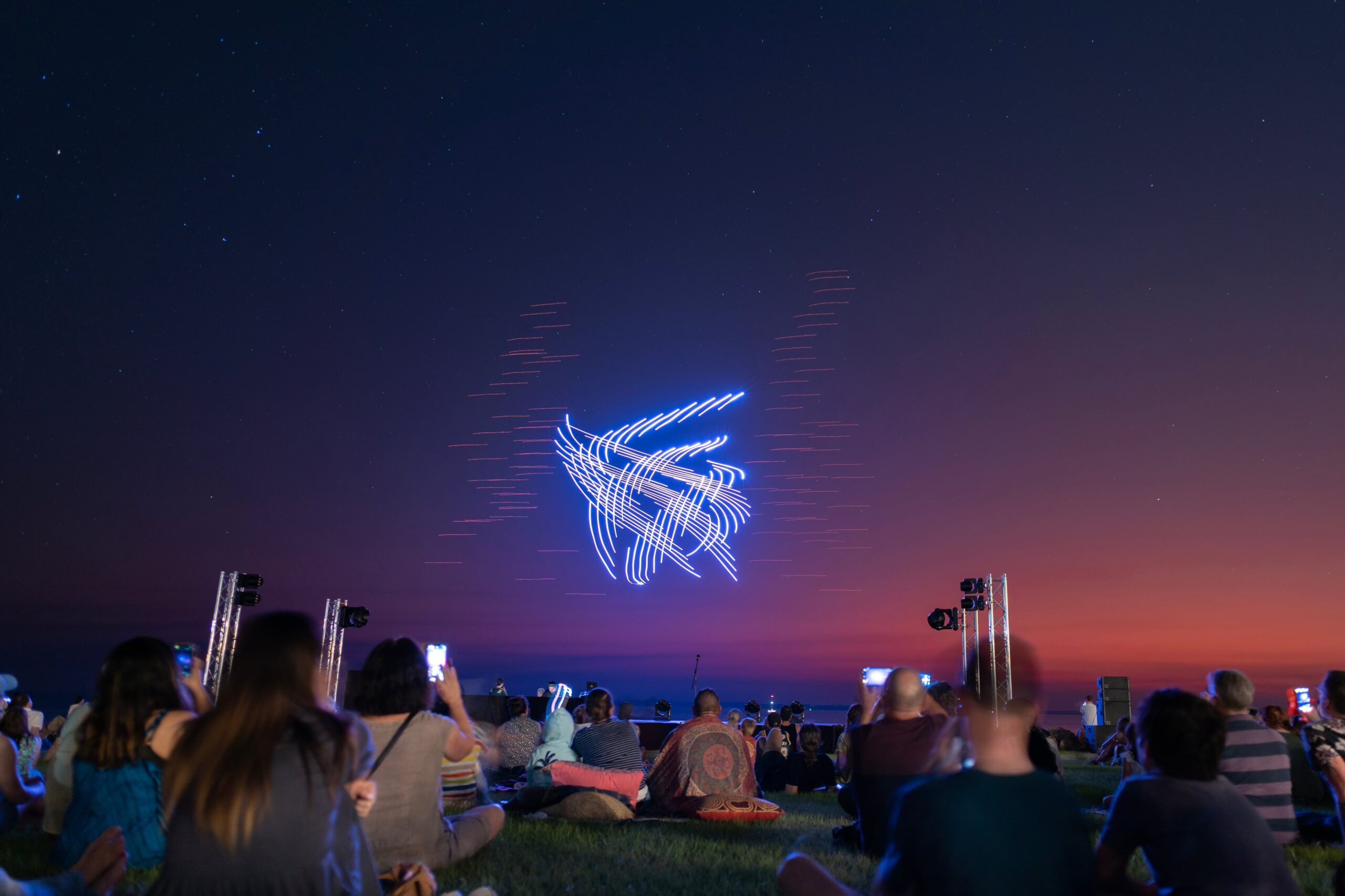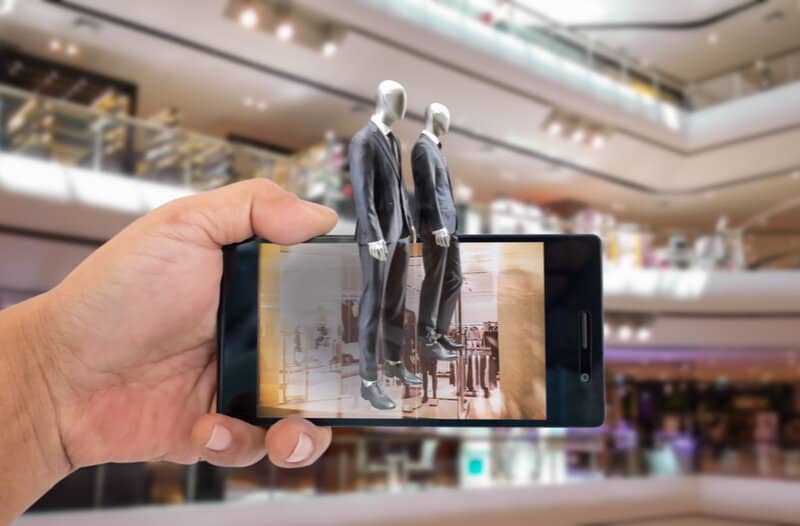- Virtual presence, real impact
- Drone technology takes event marketing to the next level
Over the years, technology has seamlessly woven itself into the fabric of our daily interactions, reshaping various industries with its transformative touch. The integration of the internet, social media, and mobile connectivity has revolutionised the way we consume media, fostering a paradigm shift that is particularly palpable in the events sector, reimagining how events are conceived, delivered, and experienced. Take a moment to think about the last event you attended. Chances are technology played a key role, from the invitation landing in your inbox to the live-streamed keynote speeches. And this is not just about convenience. The recent health crisis taught us that, even when we’re apart, technology can bring us together in the virtual world. As a result, the demand for online and hybrid events has skyrocketed, paving the way towards a greener, more sustainable future.
By cutting down on travel and streamlining event management, technology helps us tread the planet more lightly. But don’t be fooled — this doesn’t mean the end of face-to-face events. Quite the opposite, actually. When we do gather in person, technology is there to make sure it’s unforgettable, enhancing live experiences in ways we never imagined. From highly realistic holograms to drones painting the sky with light, the events industry is constantly looking for new and exciting ways to dazzle attendees. And if you’re wondering whether all this tech actually makes a difference, the numbers speak for themselves. According to Enterprise Event Marketing, embracing technology can lead to a 20 per cent jump in attendance, a 27 per cent increase in productivity, and can slash costs by up to 30 per cent. So, it’s clear: technology isn’t just changing the events industry; it’s helping it thrive in ways we never thought possible.
“It’s not comparable: It is a postage-stamp version of me, versus a full, life-size, lifelike version of me that is live and interactive. The audience is much more engaged”.
Andrew Dorcas, ARHT’s senior vice president
Virtual presence, real impact
Imagine you’re at a conference, settled into your seat with a coffee in hand. The lights dim, and suddenly, the keynote speaker who couldn’t make it across the world appears before you — not on a screen, not as a flat image, but standing there on the stage in full, glorious 3D. This is no longer the stuff of sci-fi movies; it’s the magic that companies like ARHT Media are bringing to our doorsteps, transforming the event experience as we know it. Speakers no longer need to endure the hassle of long-haul flights; a quick hop to a nearby studio is all it takes to send their 3D selves to any event, anywhere. This not only cuts down on travel time and costs but also helps our planet by reducing carbon emissions. And let’s be real — who wouldn’t want to skip the jet lag? Most importantly, appearing as a hologram doesn’t take away from the experience in any way, as the speaker will still be able to interact with the audience and respond to their questions, bringing the same energy as if they were physically there.
During the Convening Leaders 2022 conference, an annual event organised by the Professional Convention Management Association (PCMA), there was a thrilling moment when host Holly Ransom was joined on the stage by Indra Nooyi, the former chairman and CEO of PepsiCo, who looked as real as anyone else in the room. But in reality, Nooyi was in a New York studio, her holographic self projected thousands of miles away. It was surreal — watching the two women talk, laugh, and connect as if they were sitting together over coffee. And that precisely is the beauty of ARHT Media’s holographic tech; it preserves the nuances of human interaction that a webcam just can’t capture. “Body language makes up more than half of communication today. We’re robbing audiences of that, I believe, when we are simply accepting a webcam”, says Andrew Dorcas, ARHT’s senior vice president. “Webcam also doesn’t allow for that eye contact. And Holly and Indra were up on that stage essentially, to the audience at least, having that connection, which I think is very important for panel discussions, for fireside chats, for moderated conversations. It’s not comparable: It is a postage-stamp version of me, versus a full, life-size, lifelike version of me that is live and interactive. The audience is much more engaged”. And these aren’t just empty words, with numerous reports suggesting that holographic speakers achieve higher engagement levels than their in-person counterparts.
On the second day of the Advertising Week APAC 2023 event, which took place at Sydney’s Luna Park, attendees were treated to a performance that felt like a glimpse into the future: William Shatner, Hollywood icon best known for his portrayal of James T. Kirk, the captain of the Starship Enterprise, joined them virtually, his three-dimensional form projected onto the Great Minds stage. “You’re there in Australia and I’m here in Los Angeles”, he said at the time. “But thanks to Proto hologram, we’re together”. A pioneer of holographic technology, Proto enables you to beam yourself just about anywhere in real time, an ability that quickly garnered attention from Fortune 500 companies, sports arenas, and major retailers. The NFL, NBA, NHL, Netflix, Disney, AT&T, Verizon, Spotify, Rolling Stone, Kia, and Audi have all deployed Proto’s holograms at their marketing events. One of the more recent stunts saw Chris Pratt appear on Jimmy Kimmel Live! as part of the promotional campaign for his latest film, Guardians of the Galaxy Vol. 3. During the appearance, Pratt used Proto to beam a live interactive hologram of himself to Disneyland, where he greeted people as they got off the Guardians of the Galaxy ride, answering their questions in a robotic-sounding voice. Fans thought they were chatting with a clever AI, only to find out they were exchanging words with the Star-Lord himself.
“Drones are much more sophisticated. They just don’t have the same visceral reaction”.
Chris Hopkins, co-owner of Celebration Fireworks and Star Flight Drone Shows
Drone technology takes event marketing to the next level
The night sky is no longer just a tapestry of stars and the moon’s silvery glow; it’s become a playground for the silent dance of drones. These high-tech performers are reshaping event marketing, something that began to truly captivate the world’s imagination during events like the 2020 Tokyo Olympics and the recent coronation of King Charles III. These aren’t your grandpa’s fireworks; they’re a new breed of spectacle — silent, mesmerising, and eco-friendly. Where fireworks roar, drones whisper, tracing delicate patterns and corporate logos over awestruck onlookers with precision and grace. Yet, for all their sophistication, some argue that drones simply lack the gut punch of traditional pyrotechnics — the boom that resonates in our chests, the smell of gunpowder, the smoky afterglow. Chris Hopkins, whose business spans both pyrotechnics and drone displays, acknowledges this trade-off. “Drones are much more sophisticated”, he admits. “They just don’t have the same visceral reaction”. But what drones may lack in sensory overload, they make up for in innovation and versatility, offering a glimpse into an entertainment future that’s not only spellbinding but also speaks to our growing environmental consciousness.
The desert skies of Las Vegas were recently transformed into a spectacular canvas, alive with the buzz of drones in an attempt to generate excitement for the weekend’s Formula 1 grand prix. Against the backdrop of the night sky, a seven-minute ballet of lights played out. Drones morphed into high-speed F1 cars, the iconic ‘Welcome to Fabulous Las Vegas’ sign, and, with a cheeky nod to the city’s gambling spirit, a spinning roulette wheel. The mastermind behind this aerial symphony was Preston Ward, chief pilot for Sky Elements Drone Shows, who, with the finesse of a maestro and a controller in hand, orchestrated the entire show while seated behind a table. Over in California, Netflix has likewise embraced drone technology to create a sky-high spectacle for the premiere of its One Piece live-action series. Fans gathered at the Santa Monica Pier were treated to an unforgettable show, where drones took to the skies in a choreographed flight, creating massive, floating designs from the beloved One Piece universe. The event wasn’t just a hit at that moment; the social media buzz it generated kept fans talking and sharing long after the drones had landed.
Closing thoughts
As the curtains fall on these innovative showcases of technology, it’s clear that the events industry is undergoing a profound transformation. Holograms that deliver the full presence of a speaker across continents and drones that paint the skies with spectacular displays; these are not mere gimmicks but powerful tools that bridge distances and enhance our sense of connection. These innovations go beyond the ‘wow’ factor — they challenge us to reconsider our definitions of presence and community. How will our sense of togetherness evolve as these technologies become commonplace? Can virtual presence ever replace the handshake, the shared laughter, the spontaneous conversations of in-person encounters? And perhaps, the most intriguing question of all: As we stride into the future, what new wonders will we bring to life to make our world feel just a little bit smaller, a little bit closer? The answer, much like the next big tech reveal, is waiting just beyond the horizon.




